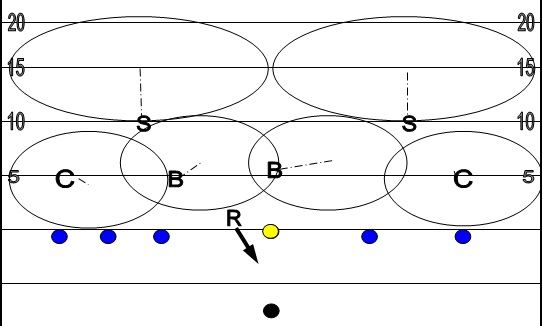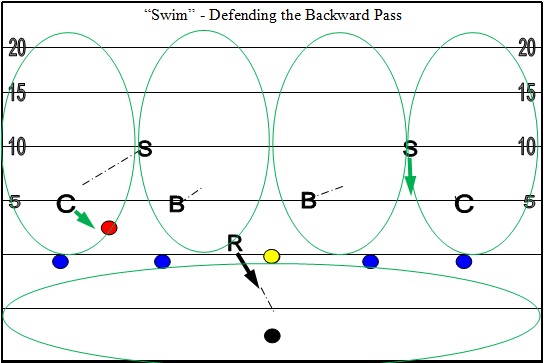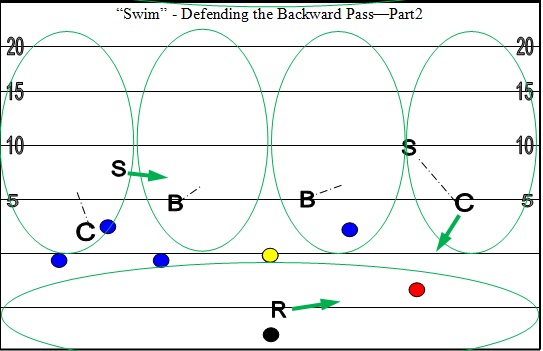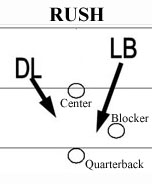There is a brand of flag football where passing all around is the norm. I don’t mean laterals, where a runner is looking to soft pitch the ball to a nearby ally. No, I mean “all-around-passing.” The strategy is simple. Throw a short or medium pass to a receiver. While the Defense is converging on the ball-carrier, quickly pass the ball across the field to an open teammate, who can streak up the field for a big gain.
I recently played against a team highly skilled in this brand of football, which hardly resembles football at all, but is more like rugby or even fast-break basketball. Incredibly the ball-carrier was not standing still looking for a pass-back to a teammate. Instead, the ball-carrier was running full speed up the field sideways, looking back for a teammate. I had never seen this strategy executed so brazenly, or so efficiently, as it created three single-play TDs.
Stinging from our defeat (it was ugly), I have devoted some time to devising the proper strategy to defeat this Offense. If you have to play this kind of Offense, either laterals or brazen all-around-passing, here is how you can limit the big plays and maybe win outright.
FORMATION
We played 7-on-7, which allows the Offense six potential receivers for the “pass-back.” Our initial thought was to play a simple 2-3-2 Zone, where we would rush two people, drop three people in short zones, and sit two safeties over the top. Typically rushing two will rattle the QB and force bad passes or even get you some sacks. But our rush was completely neutralized by the QB’s quick release. Since all the passes were short, there was no time for the rush to reach the QB. The Offense did not even put a blocking back in the backfield. As a result, we were wasting a defender in a futile rush, which only compounded the problem of defensing the “pass-back.” The better formation is the 2-4-1, where you have two Safeties at 10 yards deep and four defenders in short 5-yard zones to attack the short completion.
I recently played against a team highly skilled in this brand of football, which hardly resembles football at all, but is more like rugby or even fast-break basketball. Incredibly the ball-carrier was not standing still looking for a pass-back to a teammate. Instead, the ball-carrier was running full speed up the field sideways, looking back for a teammate. I had never seen this strategy executed so brazenly, or so efficiently, as it created three single-play TDs.
Stinging from our defeat (it was ugly), I have devoted some time to devising the proper strategy to defeat this Offense. If you have to play this kind of Offense, either laterals or brazen all-around-passing, here is how you can limit the big plays and maybe win outright.
FORMATION
We played 7-on-7, which allows the Offense six potential receivers for the “pass-back.” Our initial thought was to play a simple 2-3-2 Zone, where we would rush two people, drop three people in short zones, and sit two safeties over the top. Typically rushing two will rattle the QB and force bad passes or even get you some sacks. But our rush was completely neutralized by the QB’s quick release. Since all the passes were short, there was no time for the rush to reach the QB. The Offense did not even put a blocking back in the backfield. As a result, we were wasting a defender in a futile rush, which only compounded the problem of defensing the “pass-back.” The better formation is the 2-4-1, where you have two Safeties at 10 yards deep and four defenders in short 5-yard zones to attack the short completion.
RUSH
Therefore, if you play against this Offense, rush only one person. Know that the rusher will likely NOT reach the QB in time. The rusher must try to disrupt the timing of the throw or, at the very least, attack the QB’s dominant arm to influence a less accurate throw. The rusher must also stick with the QB after the ball is thrown to defend against the “pass-back.”
PURSUIT IN “SWIM LANES”
So, after the completion is when the play really starts. The pass-back is potentially deadly, and the goal becomes being in position to make a play rather than everyone converging on the lone ball-carrier. To prevent the pass-back from breaking wide open, defenders need to be disciplined in maintaining their zones vertically. It looks like this:
Therefore, if you play against this Offense, rush only one person. Know that the rusher will likely NOT reach the QB in time. The rusher must try to disrupt the timing of the throw or, at the very least, attack the QB’s dominant arm to influence a less accurate throw. The rusher must also stick with the QB after the ball is thrown to defend against the “pass-back.”
PURSUIT IN “SWIM LANES”
So, after the completion is when the play really starts. The pass-back is potentially deadly, and the goal becomes being in position to make a play rather than everyone converging on the lone ball-carrier. To prevent the pass-back from breaking wide open, defenders need to be disciplined in maintaining their zones vertically. It looks like this:
In this example, the pass is completed to the up receiver on the left. He immediately looks back for the pass-back. At this point, the Safeties both sprint up toward the first line of defense and the playside Cornerback (C) breaks down to make the flag pull. This means the Cornerback has vacated his swim lane. As a result, the Safety behind the play steps up and fills the swim lane.
If the Cornerback can make the play, that’s great. But chances are good that the pass-back will occur. No worries. Once the ball is thrown backward across the field, the Cornerback returns to his swim lane, freeing the Safety to work towards the middle of the field. The nearest play-side defender attacks the new ball-carrier, with the opposite Safety stepping up to fill the now vacant swim lane.
If the Cornerback can make the play, that’s great. But chances are good that the pass-back will occur. No worries. Once the ball is thrown backward across the field, the Cornerback returns to his swim lane, freeing the Safety to work towards the middle of the field. The nearest play-side defender attacks the new ball-carrier, with the opposite Safety stepping up to fill the now vacant swim lane.
DEFENSIVE GOAL
Remember, the goal is to be in position to make the play. In theory, every pass-back is an opportunity for a turnover, an incompletion, or a loss of yardage. As long as the defense is in position to make the play, they can force the Offense to be perfect in execution. The pass-back Offense can be defensed.
Remember, the goal is to be in position to make the play. In theory, every pass-back is an opportunity for a turnover, an incompletion, or a loss of yardage. As long as the defense is in position to make the play, they can force the Offense to be perfect in execution. The pass-back Offense can be defensed.









 RSS Feed
RSS Feed